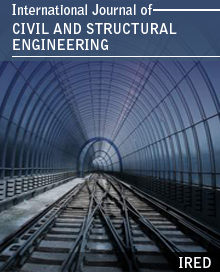A Parallel Model for Predicting the Horizontal Dynamic Behavior of Helical Wire Rope Isolators
Author(s) : GIORGIO SERINO, MARIACRISTINA SPIZZUOCO, NICOLO VAIANA
 Abstract
Abstract
In this paper, a one-dimensional (1d) parallel model able to simulate the horizontal dynamic behavior of Helical Wire Rope Isolators (HWRIs) in both Roll and Shear directions is proposed. The experimental tests performed on a HWRI, manufactured by Powerflex S.r.l. (Limatola, Italy), are first presented in order to describe the dynamic response of the tested metal device at different displacement amplitudes without and under the effect of the vertical load. The parallel modeling concept has been applied to discretize an exponential function proposed to reproduce the variation of the horizontal tangent stiffness at both small and large displacements, thus allowing to simulate the dynamic behavior of such devices by putting in parallel a purely linear elastic element, and a sufficiently high number of simple elastic-perfectly plastic elements and linear elastic gap elements. The mathematical model, requiring the evaluation of only five parameters from experimental data, has been validated by comparing the experimental force-displacement hysteresis loops obtained during cyclic tests with those predicted numerically. Good agreement between the simulated and experimental results shows that the proposed model can be an effective numerical tool to predict the horizontal force-displacement relationship of HWRIs. The presented parallel model, which allows to capture the feature of the smooth transition of the hysteresis loops from the small to large horizontal displacements ranges by adopting only one set of five parameters determined from experimental loops with the largest amplitude, is at the same time sufficiently versatile to be easily implemented in existing nonlinear finite element computer programs. Furthermore, compared to differential equation models, such as the widely used Wen model, the proposed one allows to avoid the numerical solution of a first order nonlinear ordinary differential equation for each time step of a nonlinear time history analysis, thus reducing the computation effort.

About Journals
- ISSN No. : 2372-3971
- Editor Chief : Dr. Cristina Gentilini, Alma mater Studiorum - University of Bologna, Italy
- Related Subjects : Corrosion Of Reinforcement In HVFA Concrete, Advanced Construction Materials : Microsilica In Concrete, Oceans as a Non-conventional Source of Energy, Silica Fume Concrete
 Full Paper PDF
Full Paper PDF